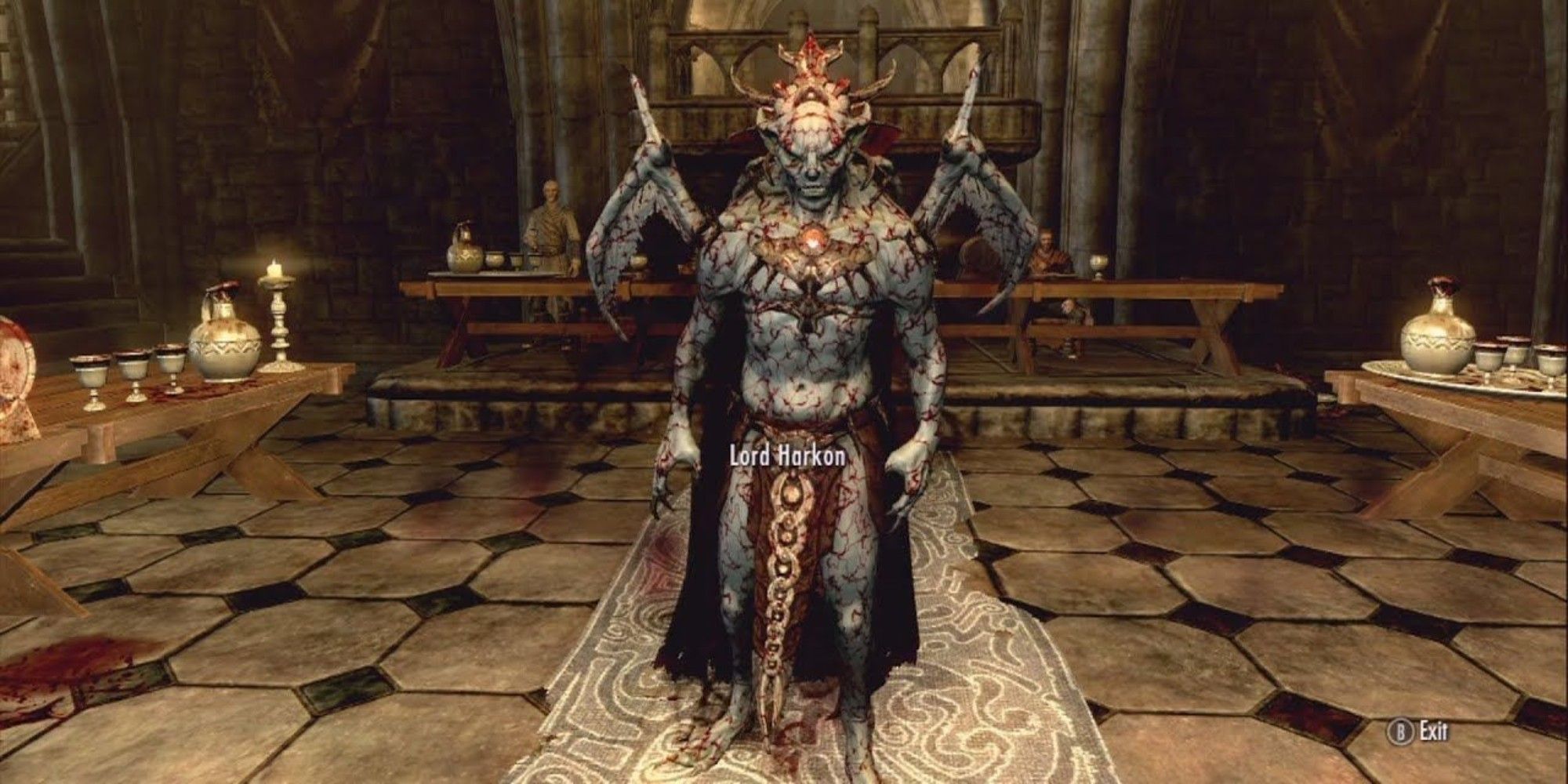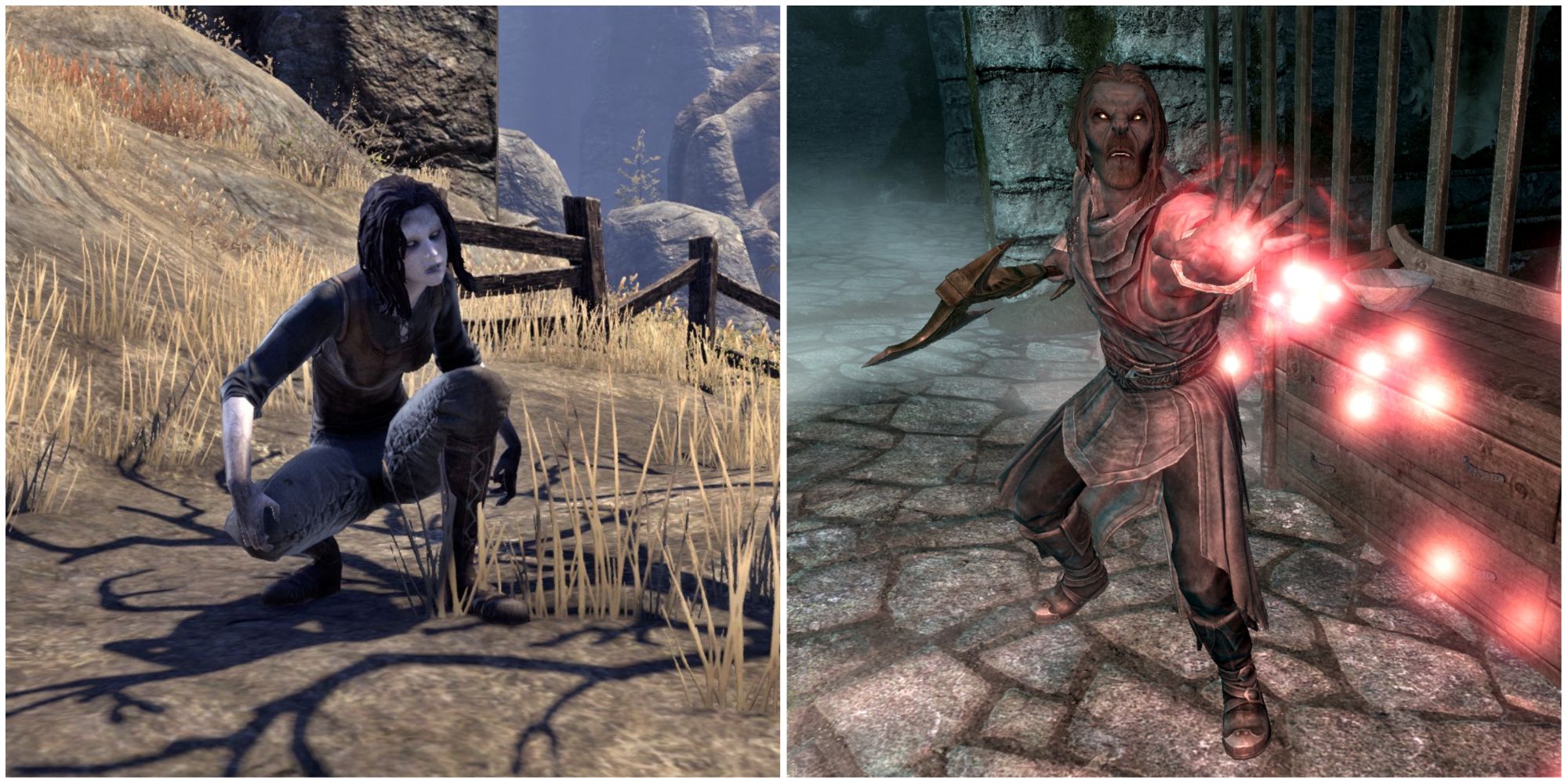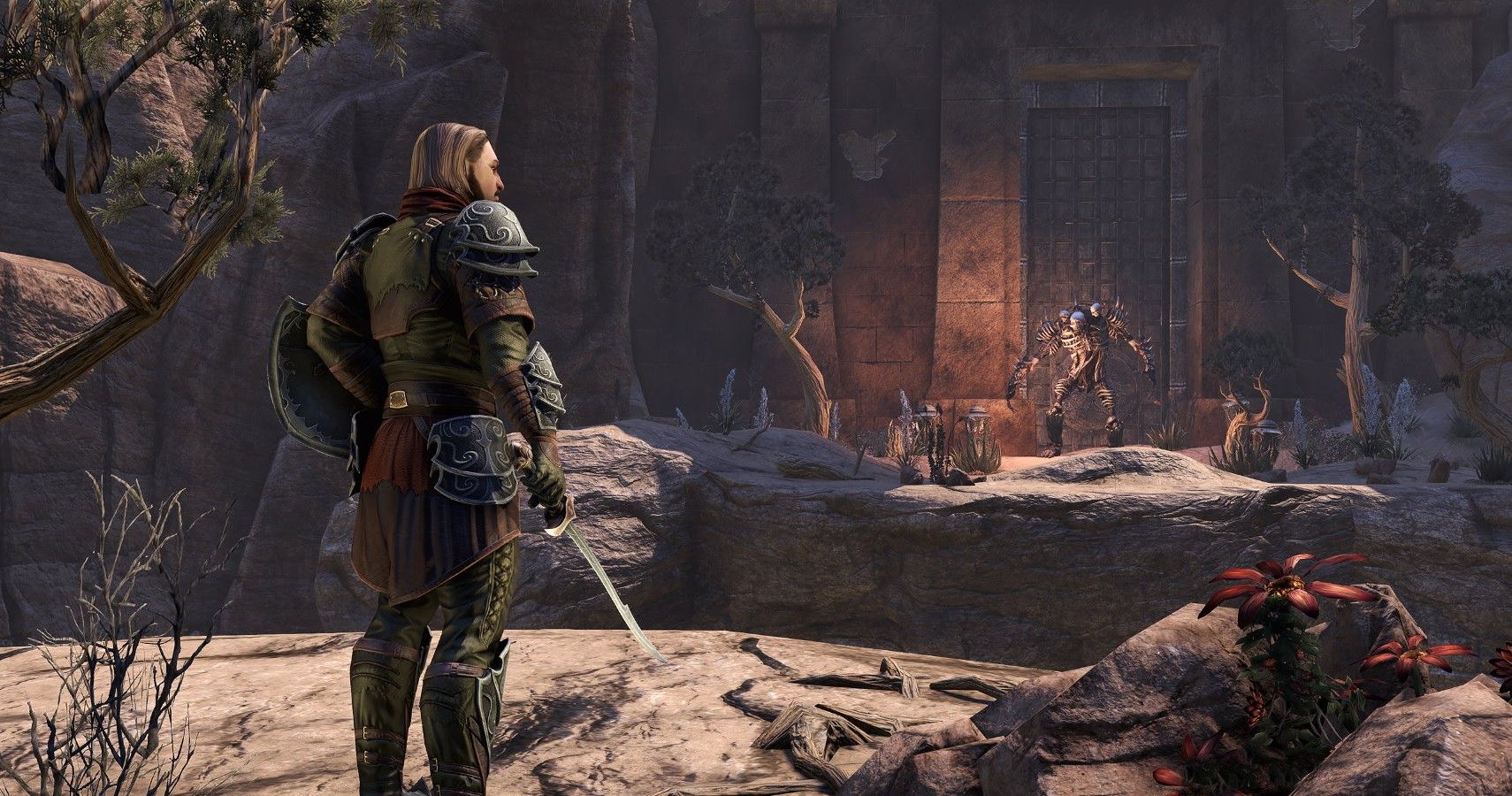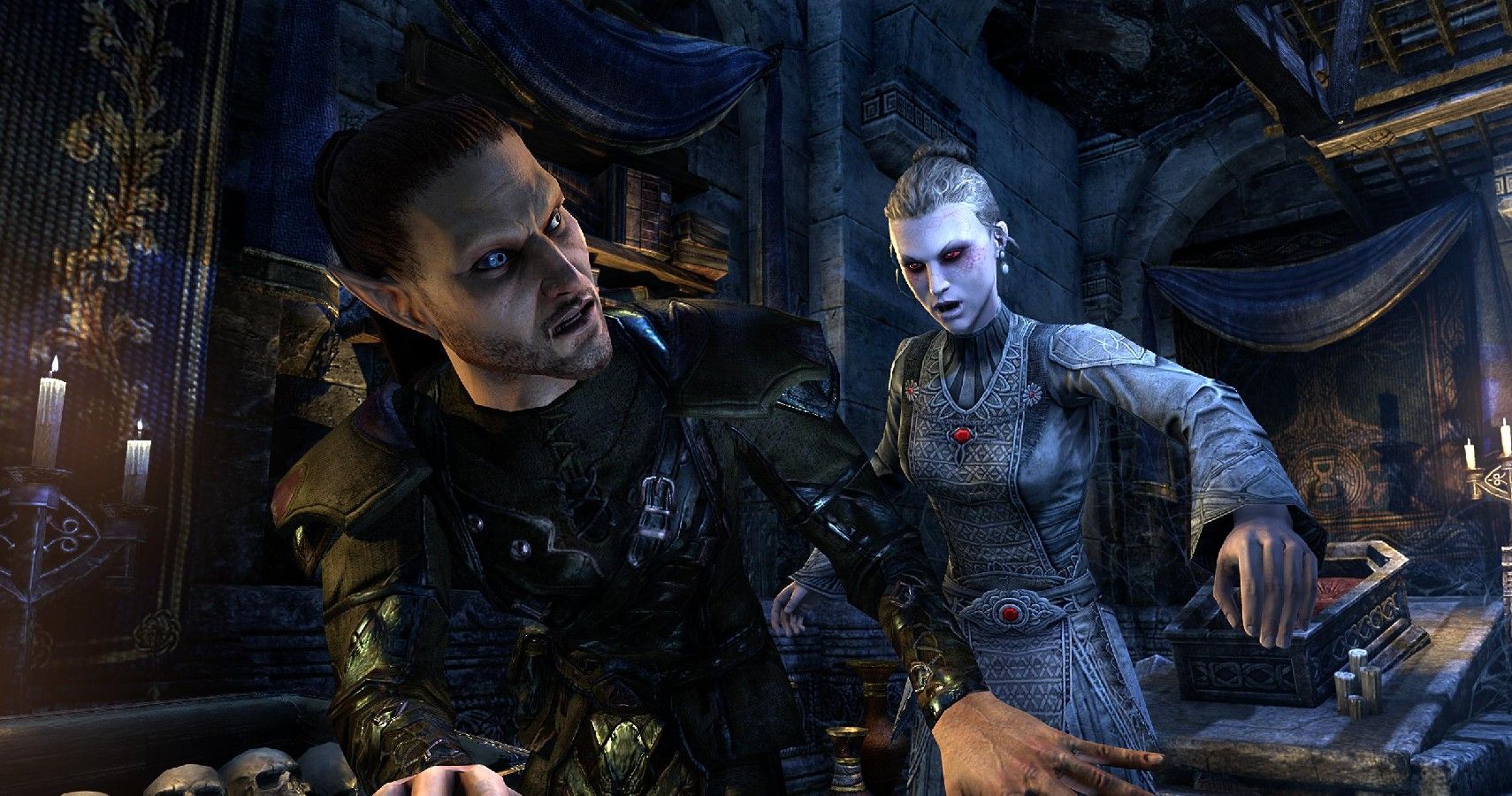Quick Links
Vampires are compelling characters, no matter where they pop up in media. The Elder Scrolls has featured vampires since the very first game, and with Daggerfall, players themselves could embrace the blood-sucker lifestyle.
As is often the case with The Elder Scrolls, there's a deep lore to explore when it comes to vampirism. There's history to learn about and gameplay mechanics that blend perfectly with narrative choices. Here's our in-depth look at vampirism.
The Origins Of Vampirism
Vampirism finds its origin in Molag Bal, the Deadric Prince of domination and the oppression of mortals. Sometime in the First Era, he forced himself upon Lamae, a priestess of Arkay. The act was so savage that she was left unconscious, and when found by nomads, they attempted to nurse her to recovery. Unfortunately, it looked like she had died, so they built her a funeral pyre.
Lamae rose from the pyre and killed the nomads, having been born as Tamriel's first vampire in a fit of bloodlust. When she came to terms with what she was and what she had done, she cursed Molag Bal's name and called to her beloved Arkay for help. When no response came, she cursed him too.
Our kind live in darkness and feed on life. Walking among us requires forsaking the gods and embracing the blessing of Mother Lamae. -Rahaja, a Redguard vampire
It is Lamae who founded the first cult of vampires and the general spread of vampirism throughout Tamriel as both a disease that creates more undead and as a lifestyle that those affected by the disease embrace.
Vampiric Diseases
The first known vampiric disease was Noxiphilic Sanguivoria, spread by Lamae herself, though it is not the only one. Vampiric diseases differ in many ways, having different vectors of transmission and symptoms. The characteristics of the vampires they create differ, too.
There are three known vampiric diseases. Apart from Noxiphilic Sanguivoria, Porphyric Hemophilia and Sanguinare Vampiris are well-documented.
As the earliest disease, Noxiphilic Sanguivoria stands out the most when compared to the others. While Porphyric Hemophilia and Sanguinare Vampiris are debilitating diseases that grow stronger over time, turning a person into a full-blown vampire after a period of about three days, it seems that some individuals in the Second Era had the ability to resist the inevitable outcomes of Noxiphilic Sanguivoria. To become a vampire, they would have to embrace the 'gift.'
Our kind live in darkness and feed on life. Walking among us requires forsaking the gods and embracing the blessing of Mother Lamae. -Rahaja, a Redguard vampire
The turn from a disease into vampirism doesn't come without a significant event. For most, this is a nightmare. In Morrowind and Oblivion, your character is given a vision of Lamae after sleeping for the first time once three days have passed while having Porphyric Hemophilia. In Skyrim, the prevalent vampiric disease is Sanguinare Vampiris, which doesn't require the host be sleeping to turn them into a vampire, and will gradually make the host aware of their vampiric characteristics coming to the fore, with each successive sunrise becoming more uncomfortable.
Vampirism is a disease, like brain rot or cholera, but far, far more insidious. One can become a vampire through certain magical items or by the curse of a powerful wizard, but the most common cause is the bite or scratch of a vampire. There are no symptoms of vampirism except this -- if the victim sleeps after the attack but before he becomes a vampire, his sleep will be plagued with nightmares. -Vampires of the Iliac Bay
The ways in which these diseases are transmitted also differ. While all three can be given as a 'gift' from a vampire to a non-vampire, hostile infection is also a possibility. Porphyric Hemophilia is the most infectious of the three - vampires imbue all of their attacks with the disease, implying it may be spread through direct transmission (i.e. through skin-to-skin or skin-to-surface contact). Sanguinare Vampiris, on the other hand, is more limited in its transmission - it is only transmitted through the use of a specific power that drains the lifeforce of another creature - called Vampiric Drain in-game.
Noxiphilic Sanguivoria is the most exclusive of the bunch. This disease is only transmitted, apart from through the gift of a friendly vampire, through the attacks of a bloodfiend. Bloodfiends are vampires who turn feral as a result of extreme thirst. This likens the disease to rabies, which enrages its hosts, compelling them to attack other living creatures to spread the disease.
Vampire Characteristics
The principle and most notable characteristic shared by all vampires is the need to feast on blood. This usually has the practical effect of keeping their disease's symptoms to a minimum, with blood satisfying their vampiric thirst, but vampires of the Noxiphilic Sanguivoria strain instead grow stronger as they feast, enhancing their vampiric powers. This may have something to do with the reverence those vampires have for the cult of vampirism established by Lamae.
And I wouldn't have to kill humans every night, merely warm-blooded creatures. Orcs have a delicious, rich brothy blood; rats are a little sweet for the only meal of the night; werewolves are a real treat, almost decadent the tincture between human and beast. A real gourmet's delight. -Vampires of the Iliac Bay
Those vampires are also more resistant to the harmful effects of sunlight than their brethren. Vampires of the Porphyric Hemophilia and Sanguinare Vampiris strains are harmed by the sun, becoming weaker or even outright hurt by its rays. This encourages vampires to be exclusively nocturnal creatures.
There are also cosmetic changes that come with vampirism. Skin is likely to take on a gray pigment, eyes become reddened, and the skin becomes sunken and sallow. Some of these effects become more extreme as a vampire thirsts, making it even more important for vampires to feed - a particularly obvious vampire is likely to be subject to shunning, threats, or even outright violence when noticed.
It also appears that within certain bloodlines, vampires exhibit different abilities. It may be the case that vampirism speeds up the rate of evolutionary adaptations, and this would make sense - vampires are high-value targets. Groups such as the vampire hunters of the Dawnguard and the Vigilants of Stendarr are committed to the eradication of vampirism - if vampiric diseases themselves can improve the survival rate of their hosts through expedited evolution, it would be a perfect synergy.
The Quarra bloodline features exceptional strength and endurance, and attacks in a state of ecstatic frenzy. Aundae vampires are potent spellcasters, seeking to hypnotize victims before feeding, while the swift and agile Berne clan vampires prefer stealth and ambush, first poisoning the victim with a bite, then withdrawing to a safe distance, returning to feed only when the prey has weakened... -Vampires of Vvadenfell, Volume I
There are certain benefits to becoming a vampire, of course. There would have to be, or no one would put up with it. Vampires enjoy improved speed and strength, and also the ability to see better in the darkness - a necessary adjustment for the diurnal turned nocturnal. Some vampires also have the ability to warp minds, becoming supernaturally charming or intimidating to others, creating friends and thralls with ease.
Vampires In Tamriel
For ages the Great Houses and the Temple have kept our land clean of the vampire's taint, but now these undead lords and their vile cattle have returned. These vampires must die, and their corrupt cattle with them, and their blood taint must be forever erased by fire and stake. -Blasphemous Revenants
It is fair to say that vampires, in Tamriel, are not well-liked. The fact that they must feed on blood to survive makes them social pariahs, and it's rare for vampires to exist within civilized societies, let alone thrive. This makes the tales of vampires who managed to do so, such as Janus Hassildor, the Count of Skingrad (Oblivion), and Sybille Stentor, the Court Wizard for Solitude (Skyrim).
It is for this reason that should you become a vampire (as a player), you'll start noticing that people treat you differently. This is more obvious as your symptoms become more obvious, and at the highest levels, people may even attack you on sight. You'll accrue high bounties and may even be precluded from joining various factions.
The vampire does not know family, or love, or hope. It only knows the desire to feed. -Vampires and their Hunters
For vampires who wish to embrace their gift, there are largely only two options for their path in life:
- Become an expert in concealing their vampirism, feeding in secret, and laying low.
- Join a vampire clan, living in communes far away from settlements, feasting on adventurers and travelers. These are usually hierarchical in structure, with a Vampire Lord at the head.
It is clear that living a public life as a vampire is not really an option. Vampirism becomes a secret, shared only with brethren and the most trustworthy. It is for this reason that you can find so many vampire lairs across Tamriel, filled with the rejects of society and those who embraced their gift.
Sometimes, you'll also find vampires thriving amongst the sneakier, more devious echelons of society. Vampires are known to be members of the Dark Brotherhood and the Thieves Guild, where both their vampiric powers and their predilection for sneakiness make them deft at the work at hand.
A Cure For Vampirism
It is important to note that before vampiric diseases progress to full-blown vampirism, they are easily cured, whether by religious, magical, or alchemical intervention. Once vampirism has taken hold, however, the cures are far more complex.
There seem to be many different ways to cure vampirism, ranging from the magical to the alchemical and even the ritual. In Iliac Bay, for example, strains of vampirism exist that can be cured by slaying the progenitor of the bloodline associated with them. This individual is called a bloodfather and holds a high rank in their respective clans.
Alchemical solutions vary wildly. One concoction, known in Cyrodiil, contains both Argonian blood and the ashes of a very powerful vampire. It seems that the death of a vampire is a running theme in vampirism cures, but it is unknown whether this is a magically symbolic or chemically salient part of the cure.
Magical intervention is also a possible way out for vampires who regret their sorry state. Falion of Morthal knows of a summoning ritual that expels the vampirism from a host's body, sending it back to the realms of Oblivion. It's also known that Molag Bal himself has the power to cure vampirism, though he is likely only to do this in exchange for a significant favor.






